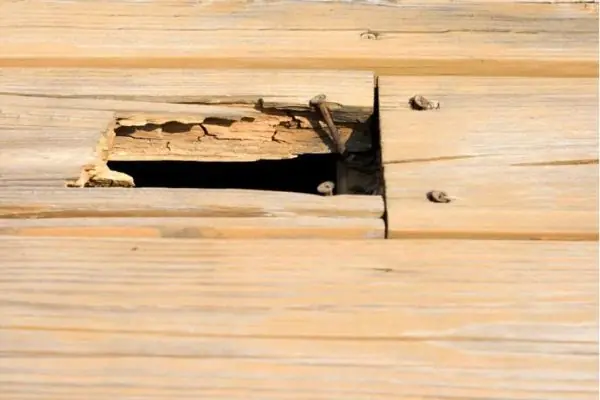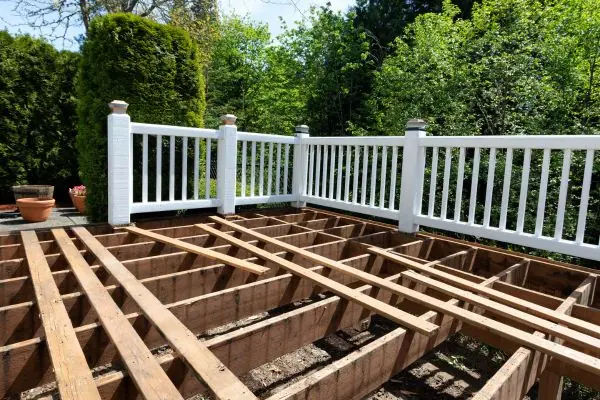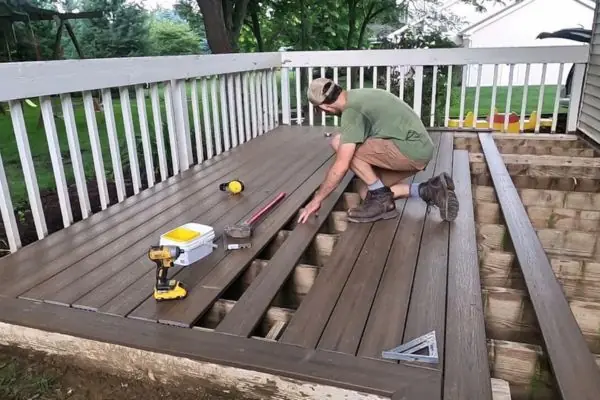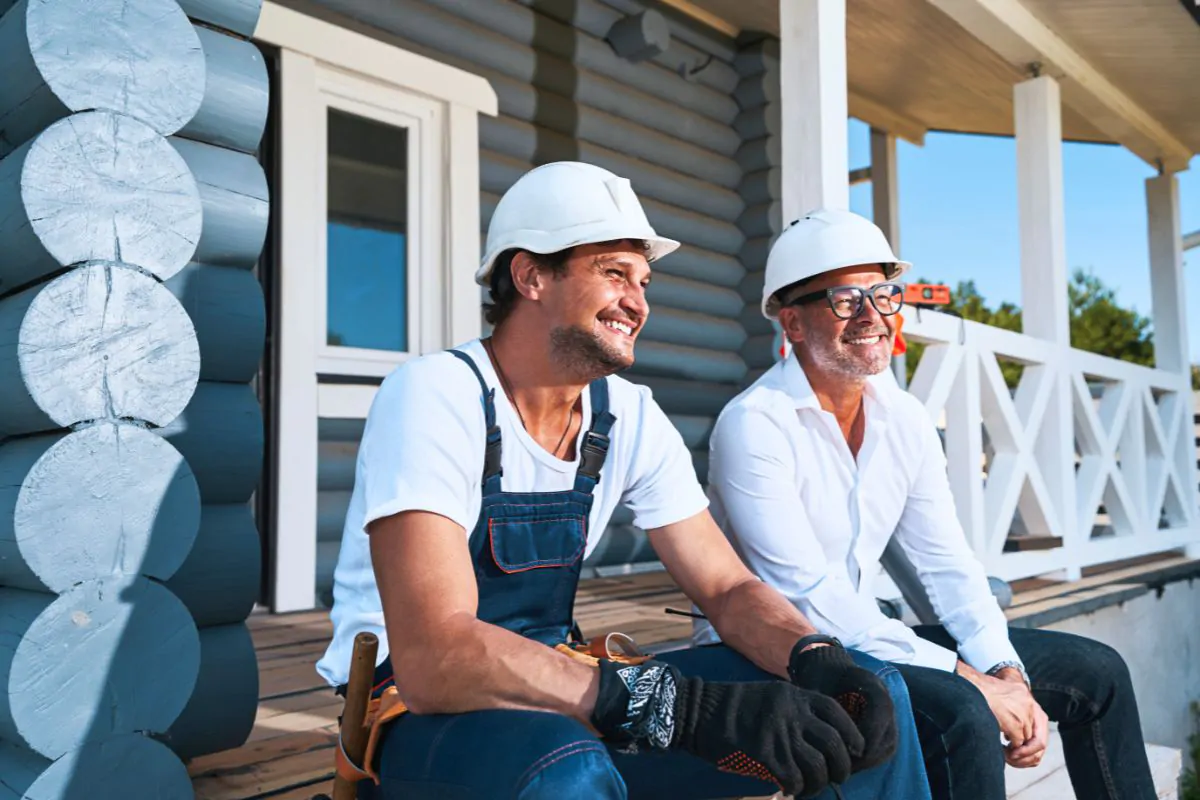Homeowners often ponder about deck board replacement, as decks endure seasonal shifts and frequent usage. Recognizing signs of wear can prevent more significant issues down the line. A deck is more than just wood and screws and varnish; it’s a dynamic structure that requires timely attention.
Inspecting the joist is critical for assessing a deck’s health. If the wood that makes up this underlying support shows decay, it can compromise the deck’s stability. The joist acts as a skeleton, and its condition directly influences when a full deck restoration is necessary.
When screws no longer hold wood securely, it signals that the deck may have reached its lifespan’s end. This is not just a cosmetic issue; loose screws can lead to uneven boards and create potential hazards. These signs guide homeowners in making informed decisions about their deck’s longevity and maintenance.
7 Signs Indicating the Need for Deck Replacement

Spotting the right moment to replace a deck is vital for ensuring safety and avoiding unnecessary costs. Signs of deterioration vary from obvious splits in the lumber to subtle shifts in the stairs that compromise the structure’s integrity. Being watchful for these indicators assists homeowners in protecting their investments and reducing long-term costs.
A. Splintered or Cracked Deck Boards
Splintered or cracked deck boards are often the most noticeable signs when to replace deck boards. These defects not only disrupt the smoothness of the surface, making it unpleasant to walk on but also point to underlying issues such as water damage or termite infiltration. If a fastener is no longer secure due to the wood’s compromised integrity, the safety and privacy of your outdoor space are at risk. This can affect both the enjoyment of your outdoor space and the security of your home.
B. Wood Rot on Posts or Beams
In the realm of home improvement, discovering wood rot on posts or beams sets off alarm bells, as these structural members are essential to a deck’s integrity. Mold and mildew are often the culprits behind this deterioration, thriving in moist environments and breaking down wood fibers over time. Immediate action with the right tool – typically a steel probe to assess the extent of decay – can arrest further damage and may save homeowners from a full-scale deck replacement.
C. Loose Deck Railings
Loose deck railings pose a risk to anyone who leans on them, potentially leading to falls and injuries. This issue often stems from a breakdown in the construction materials, which can be exacerbated by pests that weaken the wood from within, or water and stain damage spreading from the deck floor to the railings. If a railing gives way under as little as a foot’s pressure, this is an immediate warning flag that should direct a homeowner’s attention towards comprehensive repairs or replacement.
D. Rusty or Loose Connectors and Fasteners
Loose and rusty connectors, along with fasteners, are not just minor inconveniences. They signal deeper troubles that threaten your deck and your investment in your home. When elements designed to withstand pressure and hold firm begin to falter, often due to plastic parts failing or metal corroding, the integrity of the entire deck is in question. Prompt action, guided by an FAQ or a drill in hand, is imperative to restore safety and extend the life of your outdoor oasis.
Similar Post: 7 Tips To Keep Your Deck Safe
E. Poor Maintenance Signs
Signs of poor maintenance that lead homeowners to replace decking often show themselves through peeling paint, weathered decking, and compromised joists. Exposure to heat and harsh weather exacerbates the deterioration, leading to a lackluster appearance and weakened structural integrity. When the deck railing becomes wobbly or the surface appears aged beyond a simple touch-up, these visual cues suggest it is time to consider a full deck replacement.
F. Extensive Surface Damage
Extensive surface damage on a deck translates to more than an eyesore; it compromises the overall structural safety. Handrails lose their grip, a hammer and some nails become inadequate for repairs, and a plumbing issue below the deck can compromise the wood’s integrity. Homeowners with the know-how may wield a circular saw to cut away small damaged sections, but when the damage is widespread, it’s time to rely on experience and decide to replace deck.
G. Unstable Deck Foundation
An unstable deck foundation often manifests as a noticeable swaying or buckling, which poses a significant safety concern, particularly when hosting gatherings or placing heavy patio furniture on the structure.
Skilled carpentry work that includes the drilling of a pilot hole may serve as a temporary fix, but in climates like those found in Connecticut, where seasonal extremes can be punishing, this may merely be postponing the inevitable need for a new deck structure. When the firmness of the ground meant to anchor a deck becomes questionable, it is time to look beyond simple repairs. This is critical to ensuring the lasting enjoyment and security of your outdoor space.
Related Post: Choosing The Best: Deck Footing Options Explored
Repair or Replace?
Deciding between repairing a deck or replacing it becomes a question of safety over cost especially when the beam underlying a garden deck shows extensive damage. If a miter saw and some replacement lumber cannot remedy the issue, it might be time to consider rebuilding the whole structure. Ensuring a safe outdoor space should be the priority over simply trying to extend the lifespan of a failing deck.

A porch that requires frequent touch-ups or repairs may benefit more from complete replacement rather than ongoing maintenance. When the effort and expense put into preserving the existing structure surpass the investment of new construction, homeowners should weigh the long-term benefits of a new, sturdier deck against temporary fixes. Deciding to rebuild can enhance both the aesthetics and the function of the space. This will go a long way in providing peace of mind and a refreshed backdrop for outdoor living.
If a garden deck’s condition begins to affect adjacent structures, like a fence, it’s clear that patchwork solutions are insufficient. A deteriorating deck can cause a domino effect of wear and instability to nearby features, posing a greater risk to the overall outdoor environment. In such cases, replacing the deck is often the most sensible path to preserve the integrity and appearance of a homeowner’s outdoor sanctuary.
Final Thoughts
When considering deck reconstruction, seeking advice from Ludlow Deck Builders is critical for staying within budget. These experts can provide a detailed assessment of corrosion, especially on metal components, and offer guidance on whether repair or total replacement is more cost-effective. An informed decision helps manage expenses while ensuring the safety and longevity of the new deck.

As a homeowner, you may have visited a hardware store for DIY fixes. However, full deck replacement is a complex task that goes beyond the scope of what most glass hammers and home tool kits can handle. Deck building companies have access to specialized tools and materials, and their expertise is crucial for handling significant issues like structural instability and widespread material degradation.
Contacting professional contractors for an evaluation is the best course of action to ensure a thorough evaluation of your deck’s condition. This is particularly true when the signs of wear are obvious or numerous in nature. These professionals can spot early signs of metal corrosion or compromised glass panels, which might be overlooked by the untrained eye, and suggest the most effective replacement solutions to protect your investment in your home.
Conclusion
Deck replacement becomes necessary when clear signs of decay and damage, such as splintered boards or wobbly railings, threaten safety. Persistent issues like wood rot and unstable foundations indicate that repairs may no longer suffice, pushing homeowners toward the need for a total rebuild.
Ignoring these warnings can lead to greater risks and costs, as a deteriorating deck can adversely affect adjacent structures. Therefore, recognizing these seven signs is vital for maintaining a secure and enjoyable outdoor space.
Call today and let our friendly and experienced team help you decide whether a deck repair or deck replacement is right for your home!





